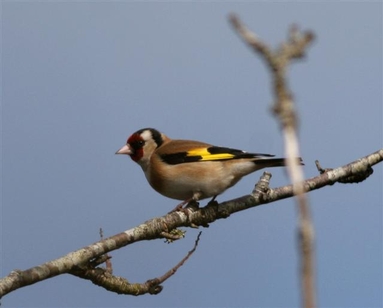Goldfinch

These beautifully marked and colourful finches have been increasingly reported in gardens in Arran this year. Some people have stated that they have had them in the garden for the first time ever.
In the wild these birds favour the smaller seeds of dandelions, thistles, groudsels, ragworts, and other members of the plant family Compositae. They tend to move into gardens in spring to exploit feeders, when seed supplies in other habitats are exhausted. Foods such as sunflower hearts and niger seeds have led to a dramatic rise in their visits to gardens over the last thirty years. The BTO’s Garden Bird Feeding Survey shows Goldfinches in gardens throughout the year. Nationally in the last eight years the number of gardens reporting Goldfinches has risen from 23% to 42%. To find out more about the BTO’s Garden BirdWatch project and how you can take part visit this website http://www.bto.org/gbw/index.htm
Watch a Goldfinch feeding and you will see how agile the bird is. With its long narrow beak it can access seeds that other finches cannot reach, including those of teasels. Goldfinches can be quite aggressive towards other species when at bird feeders.
If you do get them on your garden feeders, look at the extent of the red on the face and this will help you identify the gender of the bird in most cases. The red in males extents in a bulge, back, above, and beyond the eye. In females, it is the white that bulges forward into the red, so that the red does not extend back beyond the eye. Young birds can confuse, because although they have the black and gold wings of the adults, they do not have the red and white face, instead they have a finely streaked grey white head.
Interestingly, the movement of Goldfinches is not confined to in and out of gardens, these birds are also partial migrants. While a proportion of our breeding population remains in Britain for the winter, others migrate south to the continent, stopping when they find suitable supplies of food. From the work of the BTO, it seems more females migrate than males, but more research on this stunning bird requires to be done